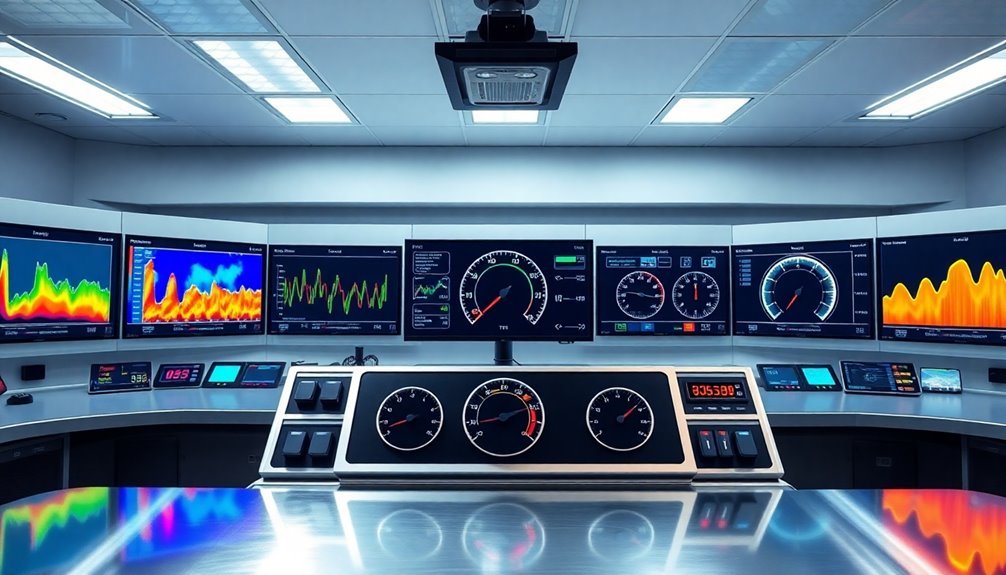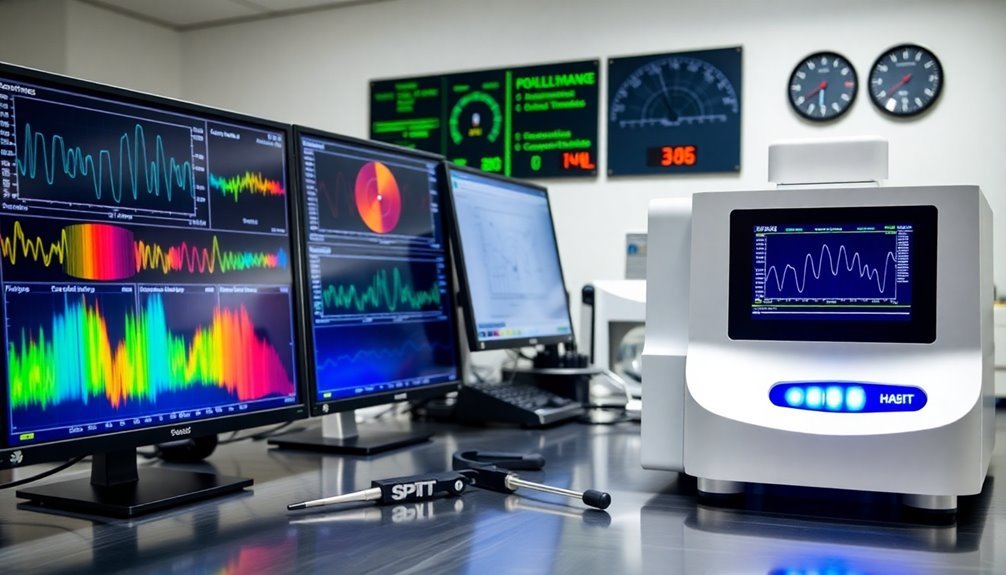To optimize your detection equipment's performance, you'll need to track five essential metrics. Start with Total Equipment Effectiveness (TEEP), which measures efficiency across all available time. Monitor your Detection System Availability Rate to guarantee consistent operations, aiming for 90% or higher. Track Quality Performance Indicators like accuracy and reliability using standardized tools. Measure Equipment Utilization by comparing actual operating time to available time. Finally, implement Real-Time Monitoring Metrics to assess system health, performance, and security. Understanding these metrics can reduce system downtime by up to 30% – discover how each one can transform your operations.
Total Equipment Effectiveness

While many manufacturers focus solely on equipment performance during scheduled production times, Total Equipment Effectiveness (TEEP) provides a more thorough view by measuring the overall efficiency of manufacturing operations across all available time.
You'll find that TEEP extends beyond traditional OEE metrics by incorporating utilization rates alongside availability, performance, and quality measurements. Rapid equipment changes require constant monitoring and updates to maintain accuracy.
To calculate TEEP, you'll multiply your OEE percentage by the utilization rate, which is determined by subtracting idle time from total available time and dividing by total available time. This calculation gives you deeper insights into your equipment's actual performance potential, including both operational and non-operational periods.
You can use TEEP to make strategic decisions about your detection equipment by identifying inefficiencies across all time periods.
It's particularly valuable for optimizing maintenance schedules, improving operator training, and developing long-term improvement strategies.
While implementing TEEP can be challenging due to data collection requirements, the insights you'll gain are invaluable for continuous improvement efforts.
Detection System Availability Rate
System availability serves as a critical metric for measuring your detection equipment's reliability and operational readiness. You'll calculate this rate by dividing your system's total available time by the total possible time and multiplying by 100.
Regular monitoring of maintenance scheduling factors significantly impacts system performance.
When your detection system maintains high availability, you're ensuring consistent operations and maximizing your investment.
To achieve world-class availability rates of 90% or higher, you'll need to focus on three key elements:
- Implement preventive maintenance strategies to catch potential issues before they cause unplanned downtime.
- Deploy condition monitoring technologies that help predict and prevent system failures.
- Establish quick response protocols to minimize repair times when breakdowns occur.
You can track your system's availability using ITSM software, which helps collect data and identify improvement opportunities.
Remember that availability is just one component of your Overall Equipment Effectiveness (OEE), working alongside performance and quality rates.
Quality Performance Indicators

In today's detection systems, quality performance indicators serve as essential benchmarks for evaluating your equipment's accuracy and reliability. You'll need to focus on several key metrics to guarantee peak performance.
Start by measuring sharpness using standardized tools like ISO 12233:2014 E-SFR or SFRplus, which employ slanted-edge charts to evaluate MTF. You'll want to monitor lateral chromatic aberration through these same charts, as it directly impacts detection accuracy. Color accuracy is particularly crucial, requiring X-Rite ColorChecker charts for precise measurement of color shifts and saturation levels.
For lens distortion assessment, implement square or rectangular grid charts to identify any optical irregularities. Track your system's exposure accuracy using step charts, and don't forget to measure veiling glare with reflective Q-13 or Q-14 charts.
You can evaluate your equipment's overall performance through metrics like MTBF and MTTR, which help you understand reliability patterns and maintenance needs. To maintain high standards, monitor your error rates by dividing total errors by units produced.
Combine these measurements with OEE calculations to get a thorough view of your equipment's effectiveness. When you're analyzing results, use the Shannon Information Capacity metric to assess your system's overall capability in combining sharpness, noise, and artifacts into a single meaningful measurement.
Equipment Utilization Measurement
Building upon your quality performance indicators, measuring equipment utilization provides tangible data about your detection system's efficiency.
You'll need to calculate the percentage of actual operating time versus available operating time to understand how effectively you're using your equipment. By implementing real-time tracking and IoT sensors, you can capture precise data about your detection system's performance and idle periods. Quick access to equipment status through phone app scanning ensures efficient monitoring of your detection systems.
To maximize your equipment utilization measurement, focus on these key areas:
- Deploy equipment management software to generate detailed utilization reports and analyze usage patterns across your detection systems.
- Install current sensors and GPS tracking devices to monitor machine uptime, operational hours, and maintenance needs.
- Establish a data analysis routine to identify underutilization trends and optimize resource allocation.
You'll find that proper utilization measurement directly impacts your operational costs and maintenance scheduling.
When you track these metrics consistently, you're better positioned to make informed decisions about equipment investments and resource allocation.
Remember that utilization data isn't just about efficiency metrics – it's also a valuable tool for predicting machine health and preventing unexpected downtime in your detection systems.
Real-Time Monitoring Metrics
Monitoring your detection equipment in real time requires tracking five essential categories of metrics: system, performance, error, security, and network measurements.
You'll need to monitor CPU usage, memory utilization, and network traffic to guarantee your system's baseline health. Regular data analysis ensures peak operational efficiency, with research showing up to 30% reduction in system downtime. Track application response times and service availability to maintain peak performance levels.
To effectively manage your equipment, you'll want to implement thorough data collection and transmission systems that feed into centralized monitoring platforms. These systems should process your metrics immediately, displaying results through customizable dashboards that provide instant insights into your equipment's status.
You can enhance your monitoring effectiveness by integrating AI and machine learning capabilities, which help detect patterns and predict potential issues before they impact operations.
Focus on smart alerting to avoid alarm fatigue – you'll want notifications only for significant deviations that require immediate attention.
Remember to align your monitoring strategy with business outcomes. This means collecting thorough data while maintaining a clear focus on KPIs that directly impact your equipment's efficiency.
Through proactive monitoring, you'll reduce downtime, improve system reliability, and make data-driven decisions that enhance your detection equipment's performance.
Frequently Asked Questions
How Do Environmental Factors Affect Detection Equipment Calibration and Performance Metrics?
You'll find that temperature, humidity, air pressure, vibration, and radiation directly affect your equipment's accuracy. They can cause calibration drift and measurement errors if you don't maintain proper environmental controls.
What Is the Recommended Frequency for Updating Performance Baseline Measurements?
You'll need to update baselines bi-weekly for standard operations, but should adjust immediately after major changes. Don't wait if you notice significant environmental shifts or equipment modifications that impact performance metrics.
Can Machine Learning Algorithms Predict Equipment Failure Based on Performance Metrics?
Yes, you'll find machine learning algorithms effectively predict equipment failures by analyzing performance metrics through regression, irregular behavior, and survival models – helping you identify potential issues before they cause breakdowns.
How Do Operator Skill Levels Impact the Accuracy of Performance Data?
Your skill level greatly affects data accuracy through measurement techniques, calibration precision, and error detection abilities. You'll see more reliable performance data when you're experienced in proper equipment setup and operation.
What Security Measures Protect Detection Equipment Performance Data From Cyber Threats?
You'll need to implement SSL VPN restrictions, regular system updates, LDAP authentication, and real-time monitoring of your detection equipment. Don't forget to track MTTD and maintain DLP systems for data protection.
In Summary
Keep track of these five essential performance metrics to maximize your detection equipment's effectiveness. You'll gain valuable insights by monitoring Total Equipment Effectiveness, system availability, quality indicators, utilization rates, and real-time data. When you consistently measure and analyze these metrics, you're better positioned to identify bottlenecks, prevent failures, and optimize your detection system's overall performance and reliability.




Leave a Reply